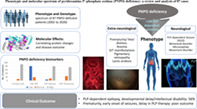- Record: found
- Abstract: found
- Article: found
Phenotypic and molecular spectrum of pyridoxamine‐5′‐phosphate oxidase deficiency: A scoping review of 87 cases of pyridoxamine‐5′‐phosphate oxidase deficiency

Read this article at
Abstract
Pyridoxamine‐5′‐phosphate oxidase (PNPO) deficiency is an autosomal recessive pyridoxal 5′‐phosphate (PLP)‐vitamin‐responsive epileptic encephalopathy. The emerging feature of PNPO deficiency is the occurrence of refractory seizures in the first year of life. Pre‐maturity and fetal distress, combined with neonatal seizures, are other associated key characteristics. The phenotype results from a dependency of PLP which regulates several enzymes in the body. We present the phenotypic and genotypic spectrum of (PNPO) deficiency based on a literature review (2002‐2020) of reports (n = 33) of patients with confirmed PNPO deficiency (n = 87). All patients who received PLP (n = 36) showed a clinical response, with a complete dramatic PLP response with seizure cessation observed in 61% of patients. In spite of effective seizure control with PLP, approximately 56% of patients affected with PLP‐dependent epilepsy suffer developmental delay/intellectual disability. There is no diagnostic biomarker, and molecular testing required for diagnosis. However, we noted that cerebrospinal fluid (CSF) PLP was low in 81%, CSF glycine was high in 80% and urinary vanillactic acid was high in 91% of the cases. We observed only a weak correlation between the severity of PNPO protein disruption and disease outcomes, indicating the importance of other factors, including seizure onset and time of therapy initiation. We found that pre‐maturity, the delay in initiation of PLP therapy and early onset of seizures correlate with a poor neurocognitive outcome. Given the amenability of PNPO to PLP therapy for seizure control, early diagnosis is essential.
Abstract
Related collections
Most cited references43
- Record: found
- Abstract: found
- Article: not found
